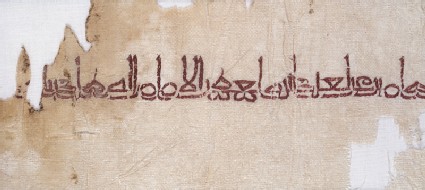Browse: 99 objects
- Reference URL
Actions
Textile fragment with tiraz band
-
Details
- Associated place
-
Near East (place of creation)
- Date
-
AD 908 - 932 (AH 295 - 320)
Fatimid Period (AD 909 - 1171)
- Material and technique
- linen, glazed, and embroidered with red silk
- Dimensions
-
29.5 x 26.5 cm max. (length x width)
along length/width 22 / 22 threads/cm (thread count)
ground fabric 0.05 cm (thread diameter)
additional fibre, embroidery 0.05 cm (thread diameter)
- Material index
-
organic › animal › animal product › silk,
- Technique index
-
assembled › woven › plain woven,woven › plain woven,
- Object type index
- No. of items
- 1
- Credit line
- Presented by Professor Percy Newberry, 1941.
- Accession no.
- EA1988.49
-
Further reading
Ellis, Marianne, Embroideries and Samplers from Islamic Egypt (Oxford: Ashmolean Museum, in association with Greenville: Curious Works Press, 2001), no. 2 on p. 13, pp. 7-8, illus. p. 13
Britton, Nancy Pence, ‘Pre-Mameluke Tiraz in the Newberry Collection’, Ars Islamica, 9, (1942), cat. 161, fig.3
Barnes, Ruth and Marianne Ellis, ‘The Newberry Collection of Islamic Embroideries’, 4 vols, 2001, Oxford, Ashmolean Museum, cat. vol. iii, illus. vol. i
Location
-
- currently in research collection
Objects are sometimes moved to a different location. Our object location data is usually updated on a monthly basis. Contact the Jameel Study Centre if you are planning to visit the museum to see a particular object on display, or would like to arrange an appointment to see an object in our reserve collections.
Publications online
-

Embroideries and Samplers from Islamic Egypt
The inscription on this tiraz fragment reads “Glory to the servant of God, Ja'far, the Imam, Muqtadir bi'llah" who ruled from A.D. 908 to 932 but the radiocarbon dating is later, 1025±40. This flowing decorative style of writing with tall stems and horizontal tails is usually associated with Iraq or Iran. The calligraphy has been skilfully transformed into embroidery by using an unusual variation of chain stitch in which the needle is taken back through the loop of the previous stitch; the result is an accentuated line formed by split stitches along one side of the chain stitch. Embroideries worked in this manner were found in tombs in Palmyra; they probably came from China (or possibly Central Asia) in the 2nd century A.D. In both instances, the reason for using this modified version of chain stitch was to increase the linear quality of the design. -

The Newberry Collection of Islamic Embroideries
A tiraz fragment embroidered in red with an inscription that reads "'izz li 'abdallah Ja'far al-imam al-Muqtadir bil(lah)" (glory to the servant of God, Ja'far, the Imam, al-Muqtadir billah).
The original accession card gives Iran as the possible provenance and dates the textile to H 295-320/908/932 AD. Radiocarbon dating however had a later result, of 1025 +/- 40 AD as the medium date, and a calibrated result (95% certainty) of 1020-1210 AD.
© 2013 University of Oxford - Ashmolean Museum

